Many people have a negative impression of Neanderthals and see them as dumb cavemen who were too undeveloped and rigid to survive. The many discoveries made in the last several years, however, have painted a quite different image of our ancient relative. The Neanderthals had been in Europe for nearly 100,000 years when the first modern humans arrived. Early Homo sapiens fossils have been found in Africa dating back 300,000 years. Neanderthals evidently did not fall short of the newcomers in any way, whether it was technology, hunting prowess, or social customs. Our forebears not only lived in the same region as the Neanderthals, but we can also trace their genetic lineage down to modern populations. It turns out that we share more characteristics with Neanderthals than was previously believed. Nonetheless, it remains unclear what caused our ancient Stone Age ancestors to disappear from the face of the earth.
Where Did the Neanderthals Come From?
How did early humans reach Europe?
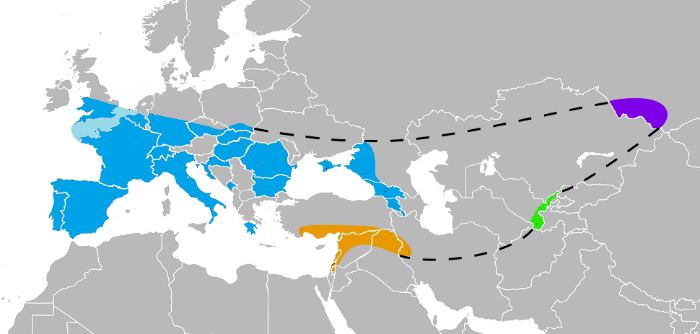
In the Schmerling Caves, Belgium, a Dutch scientist named Philippe-Charles Schmerling made the first discovery of Neanderthal bones, a skull known as “Engis 2,” in 1829. However, Schmerling mistook it for a fossilized modern human skull.
After that, miners in the Neandertal Valley near Düsseldorf, Germany, uncovered one of the first components of modern Neanderthal skeletal anatomy in 1856. These included a skullcap, numerous arm and leg bones, a hip pelvis, and remnants of a shoulder blade and ribs. The bones were odd to German scientist Johann Carl Fuhlrott; the cranium was excessively protruding, and the bones were unusually stocky.
Fuhlrott assumed that the fossils belonged to an ancient person. A debate erupted among academics about whether or not this skull shape was the result of a clinical abnormality, or whether or not it really represented a previously undiscovered ancestor of modern man.
Leaving the continent of Africa
Today, we know that it was none of them. Instead, Neanderthals represented a distinct branch of the human family tree. The term “Homo neanderthalensis” was officially used to describe this group of extinct humans. Being our distant relative, it is estimated that Neanderthals first existed in Europe and western Asia some 300,000 years ago during the Pleistocene Epoch. However, this time period is very contentious. Neanderthals became extinct about 35,000 years ago.
However, unlike Homo sapiens, Neanderthals did not make the trip to Europe. Instead, they likely diverged from Homo heidelbergensis, an even more ancient early human species, during their time in Europe. A lower jaw dating back 600,000 years was discovered in the town of Mauer, close to Heidelberg, Germany, providing more proof of their existence in Europe. Homo sapiens, however, originated in Africa and spread to Europe and Asia no more than 100,000 years ago.
It seems that the first Neanderthals followed certain natural migratory pathways as they migrated over Europe. Bones and ancient artifacts unearthed along these paths provide a map of their travels. Particularly well-liked were the valleys of rivers; the Danube is now thought to have been one of the principal ways in which prehistoric humans traveled to the heart of Europe. The renowned Neandertal Valley site was likely accessed by Neanderthals following the path of the Rhine River.
Heading toward Europe
Conversely, Neanderthals looked for ways to avoid the severely glaciated mountains. The Ice Age’s northern ice was just a bit further north during the period of greatest glaciation. The Neanderthals’ habitat in Europe was likely similar to modern northern Scandinavia, with a combination of sparse woodland and tundra covered with buckthorn, willows, and birches, as well as a wide variety of plants, grasses, and mosses. This means that during the summer, at least, Neanderthals might have made the journey to the area now known as Lower Lusatia in Central Europe. Winter’s heavy snowfall and icy conditions likely rendered the region uninhabitable, forcing the Ice Age inhabitants to seek warmer climes farther south.
First Neanderthals more than 400,000 years ago
Anthropologists have used artifacts discovered at the Sima de los Huesos “bone pit” in northern Spain to reconstruct the path of Neanderthals, or the transition from an earlier human ancestor to the Neanderthals. Reminiscent of Neanderthals, the skeletons unearthed there date back roughly 430,000 years.
The best-preserved remnants of Neanderthal dwellings may now be found in Spain. However, several fossils, particularly those from France and Italy, also provide light on their daily activities and methods of production. While the majority of Neanderthal findings come from Europe and Asia, there have been discoveries made in the Near East, the Caucasus, and the Russian Altai Mountains, suggesting that the Neanderthals’ range of residence was considerably wider than previously thought.
Stone Age tools
Tools from flint
For a long time, the stereotype of Neanderthals was that of the irrational caveman, who was thought to be nothing more than an animal. But the idea that Neanderthal man was so far behind in thought and technology compared to Homo sapiens is mistaken. The many tools that Neanderthals and prehistoric people utilized and made with such dexterity are proof enough of this.
Innovate technology from 300,000 years ago
These tools, which gave rise to the term “Stone Age,” were mostly made of flint or flintstone. Early Europeans utilized hand axes at least 600,000 years ago. However, a stone with the right form was required for this instrument, and it required very little alteration.
Yet, some 300,000 years ago, the Levallois style of stone cutting appeared, which was essentially revolutionary. The procedure begins with the first shape being carved into a stone that is chosen at random. Blades, spear points, fur scrapers, and other implements could be honed from this central core. Scientists had previously thought that this method had spread from Africa through migratory populations and word of mouth.
Nor Geghi 1 stone tools (above) in Armenia, however, demonstrate that Neanderthals living in the region about 325,000 years ago already had an advanced command of the Levallois method. Because of the great distances between the many early human groups, it seems unlikely that they would have gained this skill from any of the others. Therefore, scientists believe that Neanderthals were creative in their own right.
Neither dimwitted nor less developed

This is shown by contrasting the wide, primitive Neanderthal stone blades with the small, technologically superior contemporary human blades. Both forms of equipment were found to be equally effective, which came as a surprise. In other words, there were no evident benefits of one tool over the other. Even the most basic Neanderthal blades were a technological leap ahead of their modern Homo sapiens counterparts. This supports the idea that Neanderthals were not less intelligent than our forebears.
Neanderthals made the first bone tools in Europe
A breakthrough over sharp stones
Neanderthals probably competed with Homo sapiens in producing more than just flint. They also had access to another raw material in abundance: bones, which were more difficult to work with but were nonetheless readily accessible. Bone was preferable over stone because it was lighter and more malleable.
Oldest known Neanderthal bone tools

The ancestors of H. sapiens themselves were the first to realize this. Since the oldest bone tools appeared 1.5 million years ago in Africa. However, only more than 40,000 years ago Neanderthals crushed the bones’ ends into circular scrapers, so-called lissoirs, and utilized them in place of heavier stones to make tools with sharp edges and points. They used these convenient, easy-to-grip instruments to rub over animal skins until the leather was supple, smooth, and more water-resistant.
Excavations at two Neanderthal campsites near the Dordogne River in southern France uncovered a total of four shards of such bone scrapers, dating back to about 50,000 years ago. These tools had previously been ascribed solely to Homo sapiens. There is no indication that Homo sapiens ever visited either site, just Neanderthals.
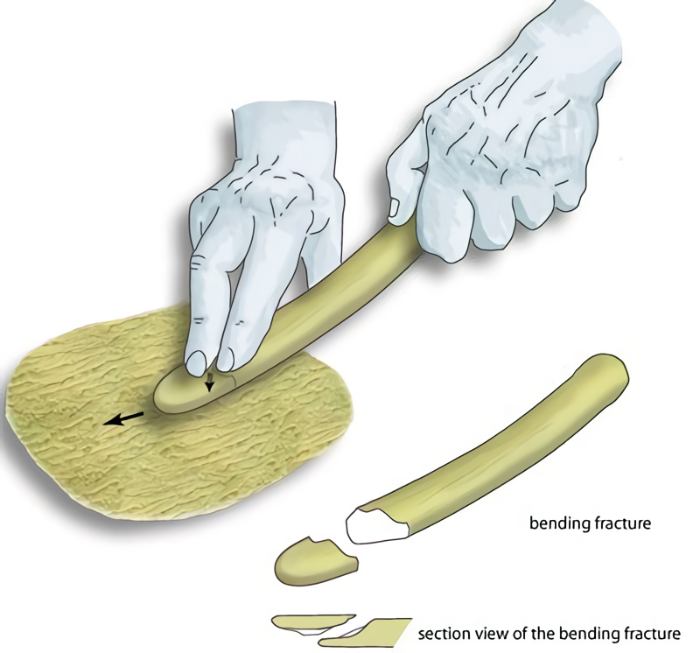
Lissoirs fashioned from deer ribs were formerly used to soften, polish, and waterproof animal hides. Ribs are able to exert a steady pressure on the animal’s skin without ripping it due to their inherent flexibility. You can see how the downward pressure causes the fragmentation into little pieces in the bottom of the picture, just like the three pieces that were discovered together.
Exchange of cultures
Microscopic analysis of the tools showed typical evidence of usage, indicating that Neanderthals likely used these bone scrapers for the same purpose that modern people would use them for in the future, namely, to smooth and soften the leather. But the bone tool discovered at Pech-de-l’Azé I in France predates even the oldest evidence of Homo sapiens in Western Europe and predates other specialized bone toolmaking capabilities by a significant margin.
This suggests that Neanderthals, not Homo sapiens, were responsible for the development of this sort of bone implement. This is the first evidence that Neanderthals and our immediate ancestors may have shared certain cultural practices. After arriving in Europe, our forefathers may have brought this method with them.
What did Neanderthals eat?
Many theories have been proposed as to how Neanderthals obtained their food. There’s no doubt they lived as hunter-gatherers. The “Stone Age diet” is said to have its origins in the diets of individuals who lived between 50,000 and 100,000 years ago and subsisted mostly on meat. This, however, is a very unbalanced viewpoint.
Meat galore, but also some greens
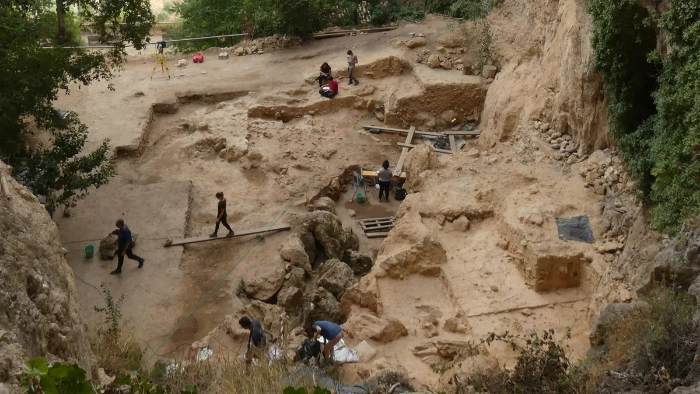
Animal bones discovered at Neanderthal sites inspired the concept of these people being “carnivores.” Since no other dietary remnants were discovered, it was concluded that the Neanderthals subsisted only on meat. Conversely, bones last a lot longer than plant fossils do in the ground. Scientists worried that our ideas about what Neanderthals ate were skewed heavily toward meat.
The discovery of small stone pellets that turned out to be fossilized Neanderthal poop was made in the Spanish city of Alicante. Groups of Neanderthals camped there often between 60,000 and 45,000 years ago, as shown by the presence of bones and stone tools.
Cholesterol and the breakdown products of plant lipids were evident in the feces of the Stone Age. Researchers were able to extrapolate an estimated percentage of meat consumption among Neanderthals from this finding. This suggests that although meat was the mainstay of their diet, vegetation also played a significant role.
The diet of the Stone Age man was not low in carbohydrate

In addition to showing that early humans were not “pure” carnivores, plant remains on Neanderthal teeth discovered in Iraq’s Shanidar Cave demonstrate that they ate a wide variety of foods. In those days before toothbrushes, the tartar on people’s teeth was full of the remnants of the food they had eaten.
Scientists discovered starch granules on the teeths, suggesting that it likely came from a variety of plants such as wild grasses, roots, tubers, and vegetables. This disproves the hypothesis that Neanderthals had a “low carb” diet that mostly avoided carbohydrates. Heat treatment signals were also present on several of the granules, suggesting that the Neanderthals boiled or grilled their plant-based foods.
Medicinal plant residues were also found in Neanderthal tartars, suggesting that prehistoric humans already had knowledge on medicinal plants. But it is possible that Neanderthals used these plants merely as food and were unaware of the healing effects. The pleasant taste of many medicinally effective plants also speaks against this.
Adaptive hunting when supplies are low
Mammoth hunters go for a fishing
Meanwhile, scientists has debunked another myth about Neanderthals: that they were mostly “mammoth hunters.” Scientific evidence does not support depictions of mammoth hunts in which whole herds are pushed down a cliff by torches and spears. Bones from mammoths are surprisingly uncommon in excavations of places inhabited by Neanderthals contrary to popular belief.
Not only the mammoths
One notable exception is the Jersey Channel Islands, where a large number of mammoth skeletons were discovered at the La Cotte de St. Brelade site. Processing signs on the bones suggest that Neanderthals at this site often hunted down mammoths and cannibalized them.
Yet more evidence suggests that Neanderthals weren’t mammoth specialists. The skeletons discovered next to Neanderthals include those of woolly rhinoceroses, cattle, deer, and horses as well. Those animal remains demonstrate the Neanderthals’ adaptability and resourcefulness.
Meat alongside fish
Whole piles of fish bones, dating back to roughly 45,000 years, were discovered in Neanderthal caves in the Caucasus, demonstrating the extent to which they adapted to the local food supply. However, the salmon from which the bones originated might be eaten by cave bears or cave lions, which also lived in the area.
A comparative isotopic study of all the bones, however, revealed that the bears were vegetarians and the lions hunted herbivores, leaving just one contender as a salmon eater: the Neanderthals of this area, who were evidently excellent fishermen.
Neanderthals were very adaptable, since they subsisted on the foods that were naturally available to them in their environment. They ate a diet that was remarkably similar to that of modern humans.
How did the Neanderthals live?
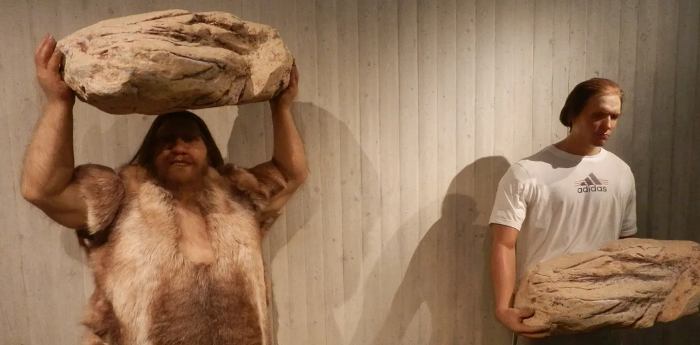
The harsh Ice Age climate was already too different from our climate, let alone technological advances, for us to be able to imagine what life was like for the Neanderthals on a daily basis. The “Stone Age conditions” describe almost hopelessly backward situations, and it is assume that the Neanderthals’ entire existence must have been a single, hard fight for survival just before starvation.
Constantly challenging, but not insurmountable
Studies of Neanderthal teeth show that periods of starvation lasting up to three months were not uncommon. However, such traces of occasional malnutrition can be found in the teeth of Inuit skulls from Alaska that are around 2,500 years old.
It’s incredible that Neanderthals apparently weren’t as malnourished as we assumed. The findings demonstrate that Neanderthals fared no worse than the Inuit people in identical environments, despite the Inuit’s superior technology.
Nursery in Neanderthals
Therefore, experts think that despite the Neanderthals’ more secluded family groupings, they nonetheless maintained intimate emotional bonds that were at least as strong as in modern families, if not stronger.
Scientists found that Neanderthal children were an integral part of daily life, even if they were not yet hunting or gathering and were instead engaged in play and exercise. This suggests that children might have played a particularly significant role in Neanderthal society.
Ornate Neanderthal burials

Other fossils demonstrate that Neanderthals ritually buried their deceased, with the most ornate burials being those of children who died at a young age, suggesting that parents must have cared for them tenderly and attentively, often for months or even years.
The make up of their teeth, for example, suggests that Neanderthal moms nursed their infants for roughly the same amount of time as is still usual for kids today. Neanderthal children had their first solid meal at about seven months of age and were weaned at around 14 months of age.
Children of contemporary humans, on the other hand, have comparably slow development processes. Neanderthals reached full maturity at the age of 15. The evolutionary benefit of this extended maturation period might be that it allows humans more time for learning.
Neanderthals were cultural pioneers
Paintings, jewelry, and cosmetics
Every fictional or nonfictional account of prehistoric humans includes references to cave paintings. The murals in the Chauvet Cave in France, which have become renowned, are undeniably the work of Homo sapiens. However, the possibility that Neanderthals also created such pieces of art is up for debate.
Neanderthal handprints

El Castillo Cave, located in northern Spain, has some of the world’s earliest known cave paintings. The minimum age of these objects is 40,800 years. Given this, they predate the Chauvet paintings by around 4,000 years. There are some potential causes for this extraordinary epoch. One possible explanation is that this cultural practice was transmitted to Europe by Homo sapiens from Africa.
However, it is not impossible that the earliest, most basic cave drawings date back to Neanderthal times. This would indicate that the handprints on the cave walls are really the traces of Neanderthal hands.
Red color derived from iron
At least at that time, Neanderthals had access to the essential dyes; they were producing red dye about 250,000 years ago. The red iron mineral hematite was used to create colors. They also moved the rock from its original location to other places where it does not exist naturally such as the site in Maastricht-Belvédère, the Netherlands.
However, the purpose of this bright red color is uncertain. It had several possible uses for the Neanderthals, including ceremonial painting, repelling insects, tanning skins, and perhaps medicinal purposes. Newer discoveries in Spain, however, suggest that Neanderthals used cosmetics for ceremonies as well.
Creativity and abstract thinking in Neanderthals

Whether or not they were fake, findings of painted and pierced shells in southern Spain indicate that Neanderthals were familiar with and wore different forms of jewelry. Such beads might be strung together and used as necklaces, for instance. The fact that Neanderthals used jewelry and ceremonial symbols suggests they were already capable of abstract thought. This ability to abstract was also seen in the form of prehistoric line drawings on the rock.
It’s widely accepted that Homo sapiens have this skill; after all, our forebears often wore ornaments and cosmetics. For a long time, people thought Neanderthals didn’t invent or even wear jewelry, and they lacked the essential level of sophistication to come up with something novel. The shell necklaces, however, are the first clear evidence of symbolic Neanderthal activity, dating back some 50,000 years, or some 10,000 years before Homo sapiens arrived in Europe.
Jewelry from the Neanderthal site of Krapina in what is now Croatia may be much older. The sea eagle’s claws with notches, incisions, and polished surfaces date back almost 130,000 years. Scientists believe the claws were previously made into a choker or bracelet based on the processing markings. The finding was impressive because this jewelry would have been created some 80,000 years before the first Homo sapiens appeared in the area.
A common heritage in Neanderthals and Homo sapiens
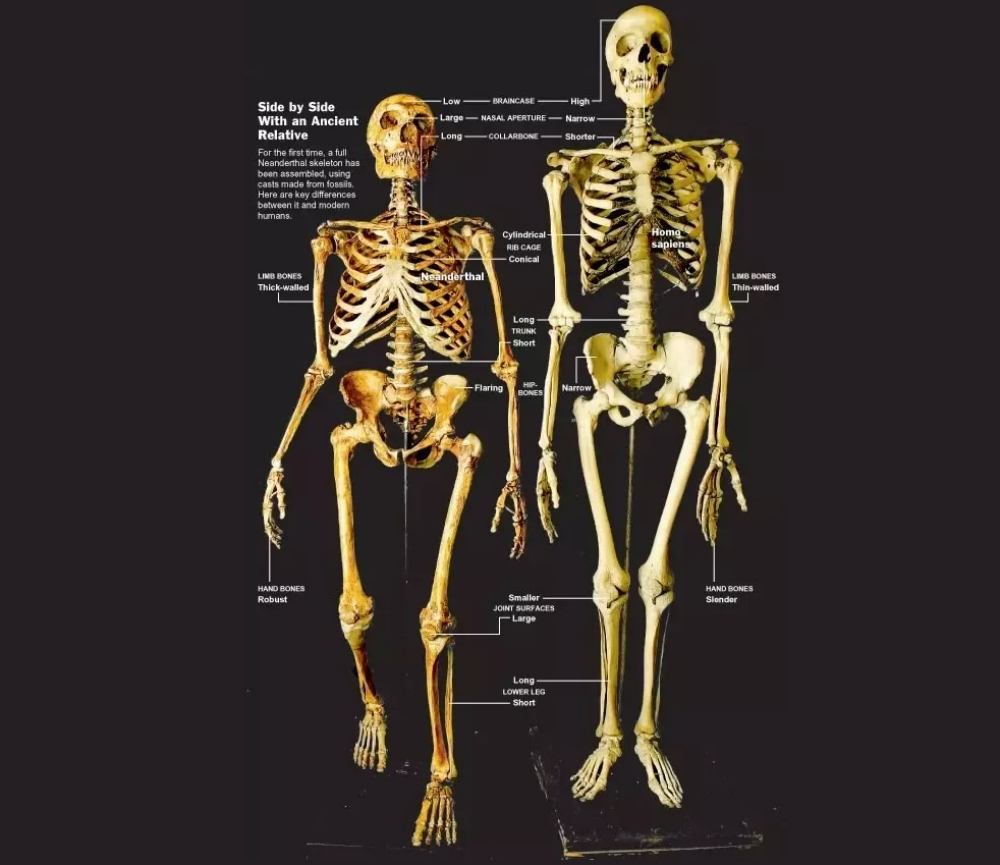
Several areas in Europe have shown signs of interaction between native Neanderthals and the newly arrived humans, as seen by cultural commonalities such as shared toolmaking practices and an appreciation for similar ornamental styles. Comparing the modern human genome to the sequenced Neanderthal genome revealed how genetically similar the two human species were.
As it turns out, we have the Neanderthals to thank for a lot of our DNA; those of us who aren’t from Africa have anything from one to four percent of Neanderthal DNA. Because, the beneficial genes were protected to ensure their continued use in the evolutionary process.
I am a Neanderthal
In frigid Europe, for instance, the Neanderthals’ superior fat metabolism was a significant advantage. An extra immune receptor was helpful since it aided in the fight against infections.
One area of the genome with an unusually high concentration of Neanderthal DNA is near the genes for keratin synthesis. Keratin is an essential component of skin, hair, and nails. Our ancestors who emigrated from Africa were likely aided by Neanderthal DNA to grow a thick covering of hair and skin, making them better able to withstand the cold.
Red hair and freckles
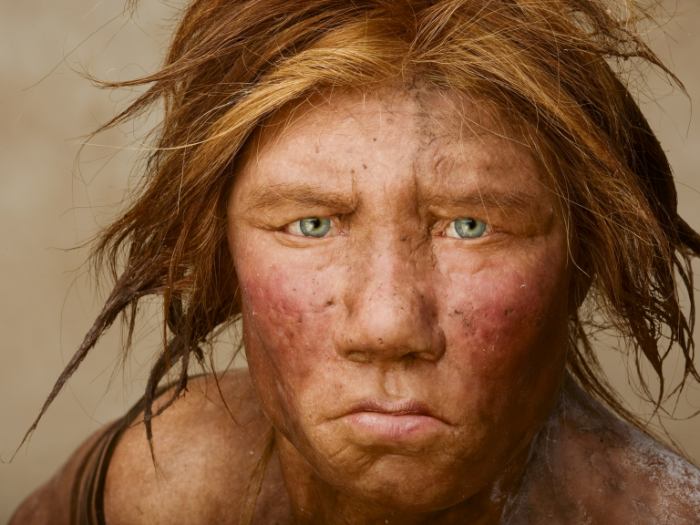
Neanderthals may also be responsible for our modern tendency toward fair complexions. Approximately 70% of Europeans have a Neanderthal gene variation that causes their skin to be naturally pale. Studies of Neanderthal DNA have also shown that not all Neanderthals looked like the stereotypical caveman: around 1% of Neanderthals had red hair, a pale complexion, and freckles.
While it may seem obvious that Homo sapiens and Homo neanderthalensis were able to mate and have children, the reality that these two species and their ancestors were separated for over 1.5 million years makes this conclusion very questionable. Throughout this period their genetic make ups may become incompatible due to differences.
Descendants, despite genetic distinctions
The genome provides further evidence for this theory by showing that Neanderthal genes are concentrated in our skin and hair regions but are missing from other areas. The X chromosome, one of the sex chromosomes, is essentially barren in this regard. And in terms of male reproductive organs, testicular tissue is similarly mostly devoid of Neanderthal DNA.
The position of the genetically incompatible subpopulations is a telltale indicator that two subspecies are only partly compatible genetically. When two infertile species breed, the resulting progeny are often sterile or at best produce a lower number of offspring, as shown in the case of mules and hinnies, which result from the mating of donkeys and horses.
While Homo sapiens and Neanderthals had a common ancestor, the two species were probably no longer compatible when they resided in Europe and Asia about 40,000 years ago. Our African ancestors who eventually left Africa were noticeably different from their Ice Age relatives, despite extensive interaction.
A competition between Neanderthals and Homo sapiens
Displaced by Homo sapiens
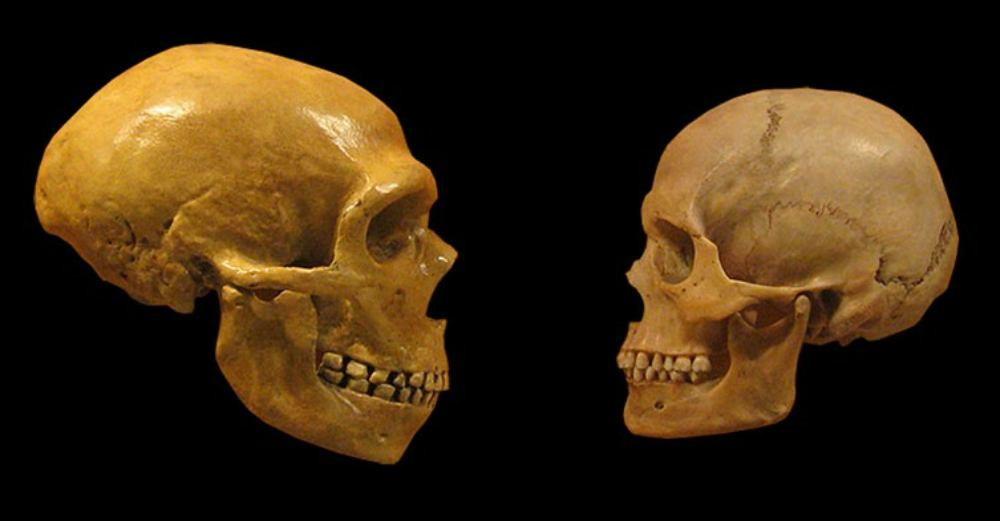
Between 30,000 and 50,000 years ago, Neanderthals became extinct after having dominated Central Europe for about 100,000 years. The earlier line of thinking was based on simpler reasoning: Neanderthals died out because they were too primitive in comparison to Homo sapiens.
“Shanidar 3” Neanderthal murder investigation
However, this theory has been debunked, and new research suggests that Neanderthals were on par with Homo sapiens, despite their many differences. If Neanderthals were so similar to our forebears, then what do you think ultimately doomed them?
Evidence of interbreeding between Homo sapiens and Neanderthals has been found in several locations, and the two early human species clearly interacted with one another, as evidenced by shared descendants. However, the two early human species did not always deal with each other peacefully, as shown by one downright criminal case.
Shanidar 3, a Neanderthal skeleton discovered in Iraq, has a deep cut or puncture wound that extends to the ribs. Was it a hunting accident or a murder? Almost 50,000 years later, anthropologist Steven Churchill of Duke University and his colleagues have solved the case through experiments on pig carcasses, demonstrating that the injury is consistent with a thrown spear.
Interspecies warfare
Scientists consider this murder case to be the first direct evidence of violent conflict between Homo sapiens and Neanderthals. However, this does not necessarily mean that modern humans deliberately fought Neanderthals: “We’re not suggesting there was a blitzkrieg, with modern humans marching across the land and executing the Neanderthals.”
The Iberian Peninsula was thought to be the last refuge of the pushed-back Neanderthals because Homo sapiens arrived there so late on their way through Europe. However, new research indicates that Neanderthal finds from that region are significantly older than initially assumed.
Close to extinction before the first encounter
Across Europe, the picture is similar but not as clear: the Neanderthal population density apparently declined drastically as early as about 50,000 years ago, long before first contact with our ancestors. Neanderthals almost died out in Europe long before they came into contact with Homo sapiens.
How did Neanderthals go extinct?
Climate change
However, the near extinction shows that Neanderthals were more vulnerable to climate change, and that a later-beginning climatic shift would have impacted the already weaker population considerably harder than the expanding Homo sapiens.
Volcanic winter
Ash layers in a Neanderthal cave in the Caucasus, for instance, are consistent with this theory; these layers are consistent with both a smaller volcanic eruption nearby and the much larger so-called Campan Ignimbrite supereruption in the area of present-day Italy; the ash clouds, especially of this last eruption, could have initiated a “volcanic winter”; all Neanderthal traces in the cave end with this second ash layer.
But other evidence contradicts this: the Neanderthals’ ability to adapt to climate change was demonstrated by their migration patterns. Like Homo sapiens, they sought out new territories to hunt in as food supplies dwindled. Because of this, we know that Neanderthals were flexible and adaptable.
Eventually absorbed by Homo sapiens
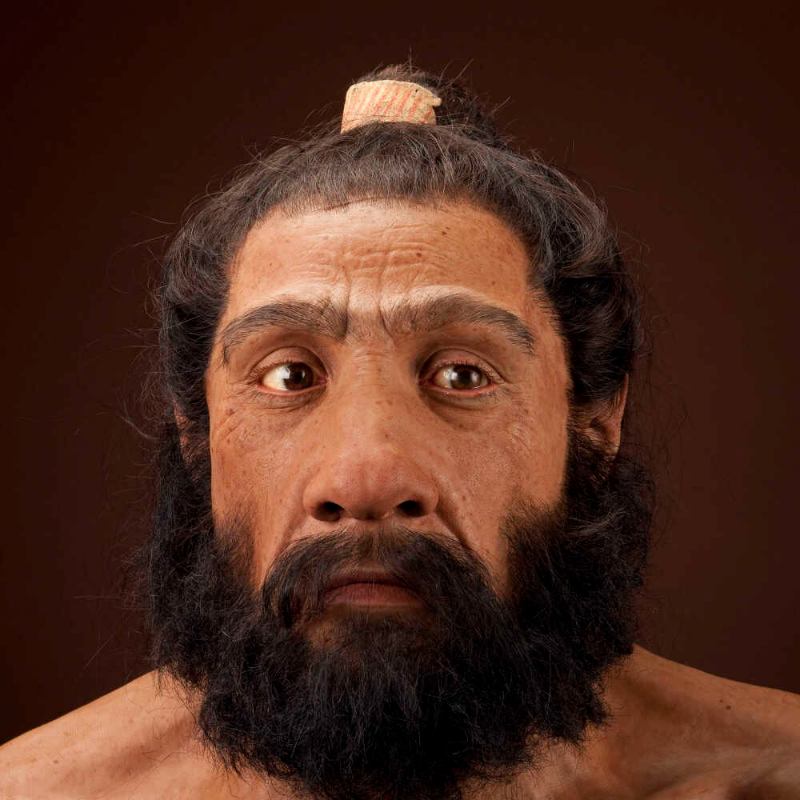
Because Neanderthals and Homo sapiens relied on the same survival strategy and environment, scientists believe that the most extensive interaction between the two human species happened at this time.
A computer model developed by Riel-Salvatore and colleagues shows how Neanderthal populations were gradually swallowed up by numerically superior Homo sapiens throughout 1,500 generations. This is corroborated if we extrapolate the population densities of Neanderthals and modern humans from the locations of their respective archaeological sites, which date back to about 40,000 years ago.
Although the Neanderthals are presumed to have gone extinct due to a combination of climatic change, competition with emerging Homo sapiens, and other, as-yet-unknown circumstances, their DNA may still be detected in almost every European today.

